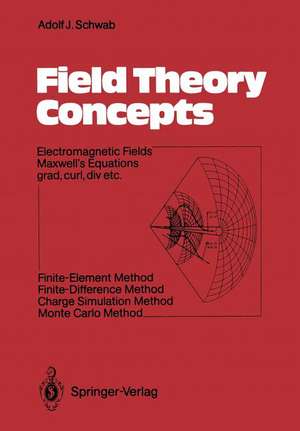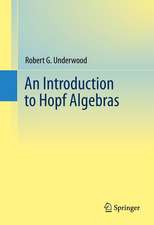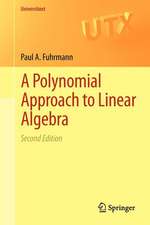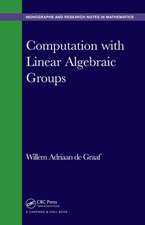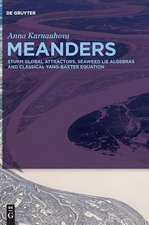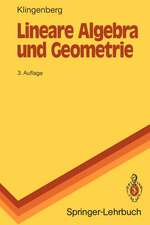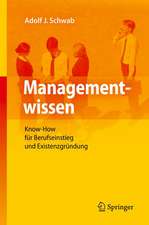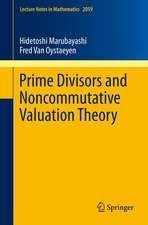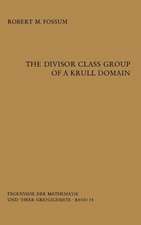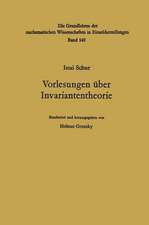Field Theory Concepts: Electromagnetic Fields. Maxwell’s Equations grad, curl, div. etc. Finite-Element Method. Finite-Difference Method. Charge Simulation Method. Monte Carlo Method
Autor Adolf J. Schwaben Limba Engleză Paperback – 14 apr 2012
Preț: 386.61 lei
Nou
Puncte Express: 580
Preț estimativ în valută:
73.99€ • 77.15$ • 61.49£
73.99€ • 77.15$ • 61.49£
Carte tipărită la comandă
Livrare economică 20 martie-03 aprilie
Preluare comenzi: 021 569.72.76
Specificații
ISBN-13: 9783642489433
ISBN-10: 3642489435
Pagini: 236
Ilustrații: XVI, 218 p.
Dimensiuni: 170 x 244 x 12 mm
Greutate: 0.38 kg
Ediția:Softcover reprint of the original 1st ed. 1988
Editura: Springer Berlin, Heidelberg
Colecția Springer
Locul publicării:Berlin, Heidelberg, Germany
ISBN-10: 3642489435
Pagini: 236
Ilustrații: XVI, 218 p.
Dimensiuni: 170 x 244 x 12 mm
Greutate: 0.38 kg
Ediția:Softcover reprint of the original 1st ed. 1988
Editura: Springer Berlin, Heidelberg
Colecția Springer
Locul publicării:Berlin, Heidelberg, Germany
Public țintă
ResearchCuprins
1 Elementary Concepts of Electric and Magnetic Fields.- 1.1 Flux and Flux Density of Vector Fields.- 1.2 Equations of Matter — Constitutive Relations.- 2 Types of Vector Fields.- 2.1 Electric Source Fields.- 2.2 Electric and Magnetic Vortex Fields.- 2.3 General Vector Fields.- 3 Field Theory Equations.- 3.1 Integral Form of Maxwells Equations.- 3.2 Law of Continuity in Integral Form Source Strength of Current Density Fields.- 3.3 Differential Form of Maxwell’s Equations.- 3.4 Law of Continuity in Differential Form Source Density of Current Density Fields.- 3.5 Maxwell’s Equations in Complex Notation.- 3.6 Integral Theorems of Stokes and Gauss.- 3.7 Network Model of Induction.- 4 Gradient, Potential, Potential Function.- 4.1 Gradient of a Scalar Field.- 4.2 Potential and Potential Function of Static Electric Fields.- 4.3 Development of the Potential Function from a Given Charge Distribution.- 4.4 Potential Equations.- 4.5 Electric Vector Potential.- 4.6 Vector Potential of the Conduction Field.- 5 Potential and Potential Function of Magnetostatic Fields.- 5.1 Magnetic Scalar Potential.- 5.2 Potential Equation for Magnetic Scalar Potentials.- 5.3 Magnetic Vector Potential.- 5.4 Potential Equation for Magnetic Vector Potentials.- 6 Classification of Electric and Magnetic Fields.- 6.1 Stationary Fields.- 6.2 Quasi-Stationary Fields (Steady-State) Fields.- 6.3 Nonstationary Fields, Electromagnetic Waves.- 7 Transmission-Line Equations.- 8 Typical Differential Equations of Electrodynamics and Mathematical Physics.- 8.1 Generalized Telegraphist’s Equation.- 8.2 Telegraphist’s Equation with a, b>0; c=0.- 8.3 Telegraphist’s Equation with a>0; b=0; c=0.- 8.4 Telegraphist’s Equation with b>0; a=0; c=0.- 8.5 Helmholtz Equation.- 8.6 Schroedinger Equation.- 8.7Lorentz’s Invariance of Maxwell’s Equations.- 9 Numerical Calculation of Potential Fields.- 9.1 Finite-Element Method.- 9.2 Finite-Difference Method.- 9.3 Charge Simulation Method.- 9.4 Monte Carlo Method.- 9.5 General Remarks on Numerical Field Calculation.- A1 Units.- A2 Scalar and Vector Integrals.- A3 Vector Operations in Special Coordinate Systems.- A5 Complex Notation of Harmonic Quantities.- Literature.
